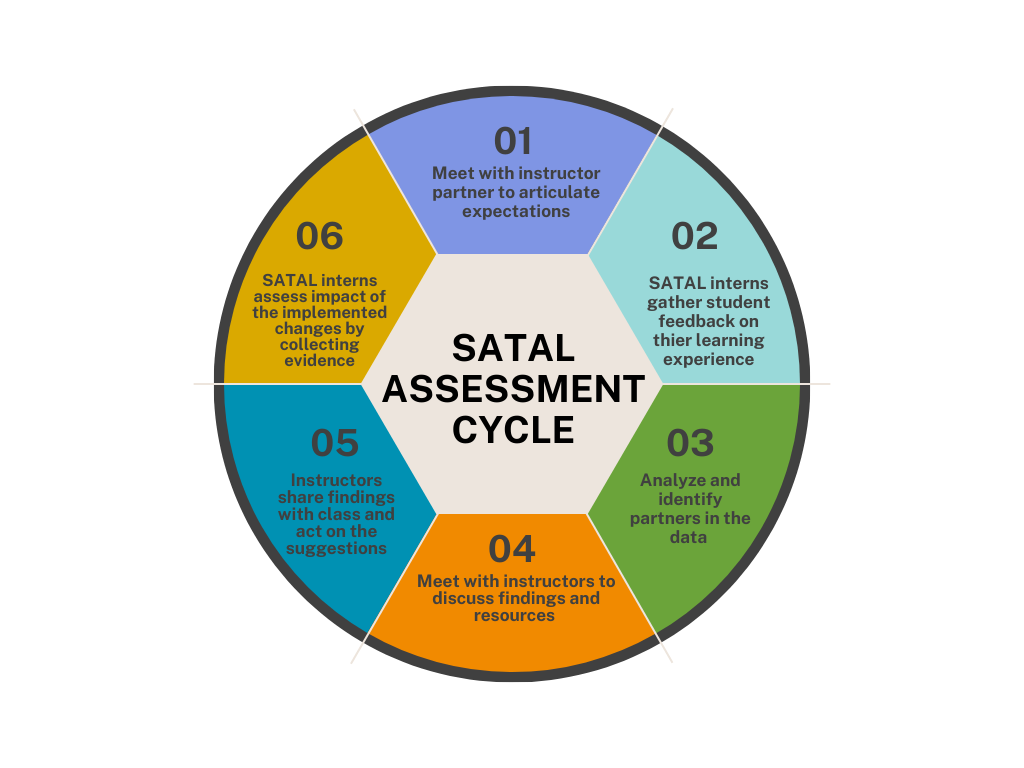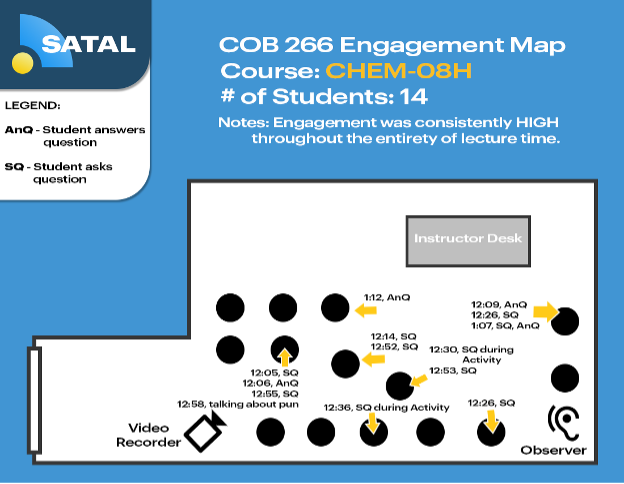Scholars from a variety of disciplines across the globe have been creating fruitful partnerships with undergraduate students and engaging them as co-creators of their educational development to enhance teaching and improve student learning in higher education. The "Students as Partners" (SaPs) movement in higher education places students, faculty, and staff as valued collaborators in the teaching and learning process (Mercer-Mapstone et al., 2017). To that end, SaPs provide students with an opportunity to improve pedagogical practices and create meaningful professional development learning experiences that will complement their degree completion and transfer to their future careers (Cook-Sather, Bovill, and Felten 2014; Matthews, 2017, Signorini and Pohan 2019; Signorini, 2023).
Benefits of partnering with SATAL
- SATAL partners, the students assessing courses, receive professional development in data collection, analysis, and reporting.
- Data are tailored to a program or instructor’s particular needs and can be collected from in-person or online observation, video tapping, or student interviews.
- Summary reports are descriptive and objective (as opposed to prescriptive and evaluative); they accurately describe student learning experiences in a course without bias.
- Students in their classes reflect on their course experience in a non-threatening manner since their peers collect this assessment data, creating a respectful and collaborative environment for students to speak freely.
- All findings are confidential and not shared with anyone except the instructor who made the request.
- Instructors can use findings for ongoing classroom assessment, in support of their teaching awards and tenure and promotion materials, and for action-research purposes. Findings can be insightful in assessing student learning outcomes and can be used up to twice a year.
What is the SATAL process?
-
SATAL coordinator contacts the instructor to confirm the type of support requested (see options below).
-
SATAL interns collaborate with the requesting instructor to gather confidential classroom data on the course or program and provide the instructor with a summary of findings.
-
SATAL staff analyze the classroom data to identify partners.
-
The instructor meets with SATAL staff to co-reflect the findings and shape the learning experience with suggestions so instructors can implement data-informed decisions.
→ This sample video illustrates the SATAL staff and instructors meeting to discuss findings.
-
The instructor shares findings with the class and acts on the suggestions discussed.
-
The instructor invites SATAL to assess the impact of the implemented changes by collecting evidence.
What types of assessment are offered by SATAL?
Mid-Semester Feedback
- The SATAL team can help you collect the data you need to gauge what helps student learning in your class and determine what else they need to succeed. At the same time, the SATAL interns ensure their peers offer descriptive, specific, respectful, and vulnerable feedback to the instructor.
- In the SATAL program, we implement a Small Group Instructional Diagnosis (SGID) tool consisting of three questions, as shown below, following the Think-Pair-Share approach. Students respond to the three questions individually, then in groups of 3–5 students through Qualtrics surveys, and finally, the students reconvene to provide a consensus on the responses. Through this process, students reach a consensus on what works and make suggestions by collaboratively discussing with their peers.
- What helps your learning in this class?
- What suggestions do you have for the instructor to help your learning?
- What actions are you taking to improve your learning? (self-assessment)

-
Also, the instructor could suggest adding more questions based on their interest. For, e.g., we have courses using labor-based contracts, and instructors would like feedback specific to that. The SGID takes 30 minutes of class time at the beginning of class or the end, depending on the instructor's choice.
-
Once in the classroom, SATAL students set clear expectations for their peers:
-
They will explain to their peers in the class that you/the instructor value their input/feedback and that you care about their learning and will respond/incorporate students’ feedback in the course as you see appropriate.
-
Also, SATAL students will facilitate the input to make sure your students provide complete comments about how and why the teaching practices have been helpful and the why and how of their suggestions.
-
-
The only challenge is ensuring the students stay after the instructor leaves the class. Some students feel that the class is over and leave after the instructors. We encourage instructors to let the class know they will return after the assessment session concludes. Within a week of our class visit, the instructor will receive a spreadsheet generated by the SATAL interns. The spreadsheet has two tabs: group survey results and class consensus. The students' comments are grouped into categories and included from the highest to the lowest frequency. We recommend instructors start with the class consensus document since it summarizes the statements most students agree on collected using Turning Points.
-
Interpret feedback with SATAL partners (see our handy mid-semester feedback interpretation guide).
- Student facilitators will collect feedback and write a summary report of findings (see an example of a SATAL summary report).
- Provides a quick way of informing faculty about what is working and/or what is not working so that timely instructional adjustments may be made.
- When sharing the MSF findings with students, the instructor will communicate what aspects of their approach instructors will continue, what they plan to adjust, and the reasoning behind these decisions based on their feedback. This transparency can encourage meaningful reflection and engagement.
Classroom Observation with COPUS
- A classroom observation using a validated tool provides quantitative data to complement the student feedback collected using the SGID for a holistic approach to teaching. The Classroom Observation Protocol for Undergraduate STEM (COPUS) is a tool to code instructor and student behaviors over two-minute intervals. Data are then analyzed and reported in a document, noting how much time (as a percentage of two-minute intervals) each of the behaviors and interactions was observed during the class session. These data help instructors identify how much time is spent on each behavior and their practices utilized during class time (Reisner, 2020). The COPUS observation involves videotaping the class session to be able to revise the codes once the session is over. The video recording is available for instructors to request through a Box link. Here are some guidelines on how to use the COPUS data. Moreover, SATAL interns will map the instructor-student and/or student-student interaction during the observation (see sample map image).
-
What do these data look like? See an example COPUS report.
- How do I use these data for merit, promotion, and tenure packets? Consider these Guidelines for Using COPUS Data to Inform and Represent Teaching Practices
- How do I make my lectures more engaging? See our tips for interactive discourse, or browse our engaged teaching resources.
-
- To close the assessment cycle, we encourage instructors to meet with us after collecting the classroom data to analyze findings in community. The students will share their expertise as UCM students, and Adriana will share evidence-based teaching practices to respond to the students' needs.

Final Course Evaluation Questions as Mid-Semester Feedback
- Unless instructors would like to receive specific feedback on an intervention (specific practice), it is suggested to use the same questions found in the final course evaluation, so the students get practice at providing feedback before completing the final course evaluation. For small classes, the following open-ended questions could be used based on instructors' specific interventions.
- Describe your efforts and engagement in this course
- Describe the learning environment in this course
- Describe the instructor’s interactions with students
- Describe the instructor’s responses to your work
- Please assess the overall effectiveness of the instructor and explain your reasoning.
- Please assess the overall quality of the course and explain your reasoning.
Focus Groups
- SATAL interns facilitate discussion with in-class students, collect the data, and produce a professional summary report (see an example focus group report).
- The SATAL Program does not assume responsibility for recruitment of students to participate in focus group or interview sessions.
What is the SATAL timeline?
The classroom assessment tool below will help you gather perspectives on learning experiences at different times during the semester and collect timely, accurate, and in-depth student feedback. The assessment tool could have three primary functions: 1) to provide feedback to instructors about the level of engagement of their students given the course choices made, 2) to provide evidence of teaching effectiveness for promotion and/or tenure cases and teaching awards, and 3) to support classroom research.
How do I make the most of my assessment experience?
-
Share the assessment findings and discuss the changes you will and will not implement with the class, providing the rationale based on the collected feedback.
- Consider the SATAL handouts included in the Closing the assessment cycle slides deck with suggestions on student-student interaction and active learning activities, which will add extra codes to the next iteration of your class observation.
- Before final course evaluations, share the student feedback rubric to guide students as they reflect on the class and instructional support.
- Consider embedding these videos in your presentation or CatCourses to inform students about best practices for providing feedback on teaching before final course evaluations.
Student-Centered Feedback |
Content-Centered Feedback |
Assessment Resources
Explore strategies for asking students for feedback before, during, and after your courses.





